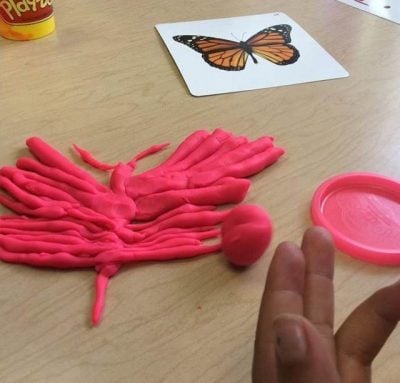Since the field of speech-language pathology is so broad, we come across students with many types of abilities, including the deaf or hard-of-hearing (DHH) population. I happen to work in a school that has a program for our DHH kids; our team includes teachers of the deaf, ASL interpreters, and me, the SLP! Ours is a Total Communication program, so we use all modes of communication to teach our kids academic skills. Here are some helpful tips and a list of my favorite materials I use with my DHH students.
Vocabulary
- My pre-K and kindergarten DHH students mostly work on nouns and adjectives in speech therapy. I use a lot of play objects and books to target these, labeling as many items as I can for them. Along with these materials, I use a LOT of visual aids and tactile materials/strategies for these students to improve their learning and carryover of novel words.
- As we walk to the speech room, we often communicate about bulletin board displays we see in our school’s hallway. We discuss letters, colors, numbers, and common objects we see on our way. It’s a great strategy to make the best use of every minute I spend with them!
Grammar
- My older students typically have goals for sentence structure. Since the syntax of ASL is very different from that of spoken and written English (which is what they are still expected to learn and use in the classroom), their writing skills can suffer in academic settings.
- To help improve their sentence structure, we start working on “subject + verb” style phrases when they are younger, and we build from there. Once they understand and master this format, we add in adjectives and other words that enhance their sentences and improve others' understanding. I ask a lot of “wh” questions to elicit these “subject + verb” responses.
- Then, when we begin to practice using complete sentences, we often use Signed English during these lessons (which, unlike ASL, includes the use of articles, conjunctions, affixes, etc.). Using visual sentence strips with pictures for “who,” “what doing,” “where,” etc. has been extremely helpful to me in teaching grammar.
- I use a lot of videos and verb photo cards to elicit grammar goals. We also use Play-Doh “smash mats,” many of which have dots where the student can smash the dough under printed words or picture symbols as they verbalize and/or sign the words. The tactile input is sometimes the missing puzzle piece they need to express those sentences.
My Favorite Materials
1) Sensory bins! They’re fun and offer so many possibilities for busy little hands!
2) Charades
3) Play objects (my students especially love play food and tableware)
4) Play-Doh
5) Crayons/Markers—Ask them to draw a picture and describe it to you.
6) Actual food—Recipes are great for learning vocabulary, sequencing, and measuring, and it's also a multisensory experience!
7) Play farm
8) Hedbanz—My older students love this game for adjective goals!
9) Wordless book
Author: Greta Abbott, MS, CCC-SLP.

